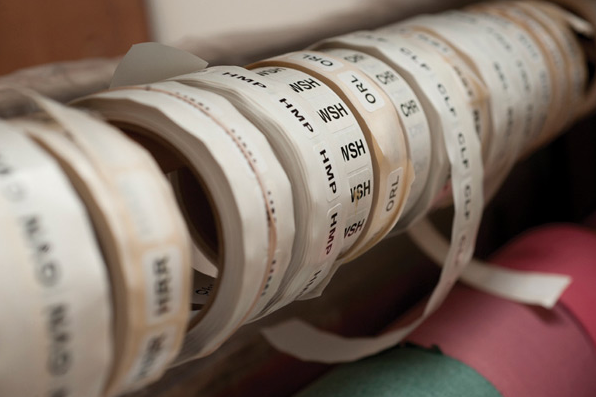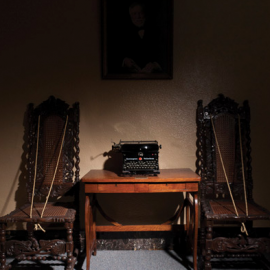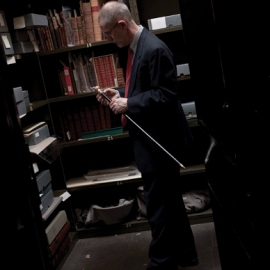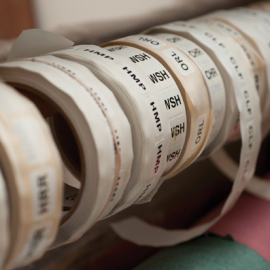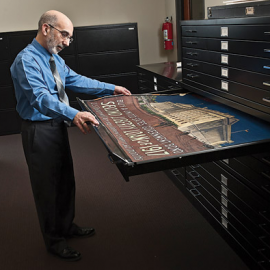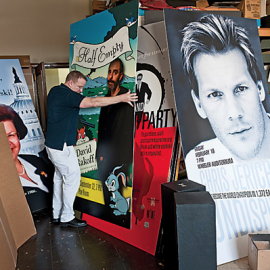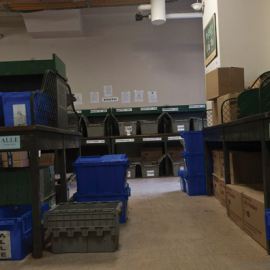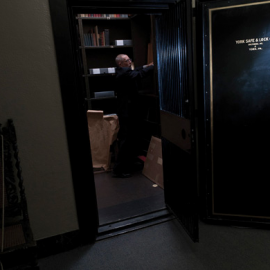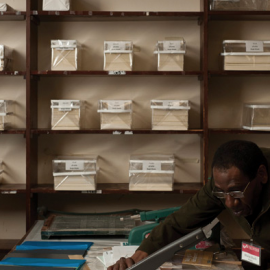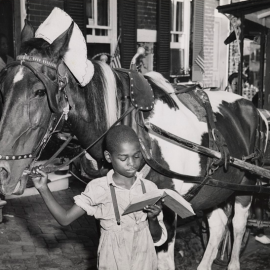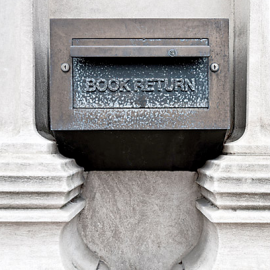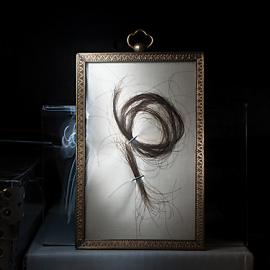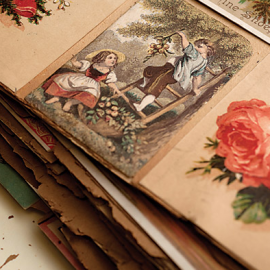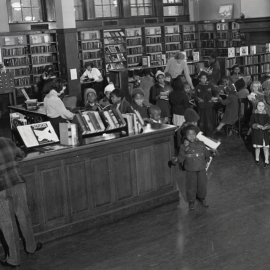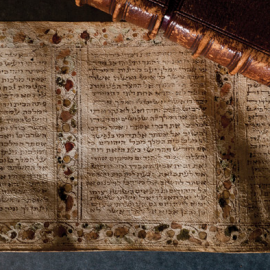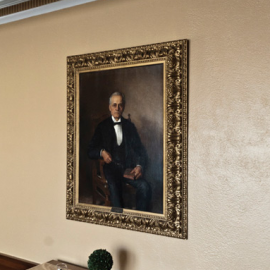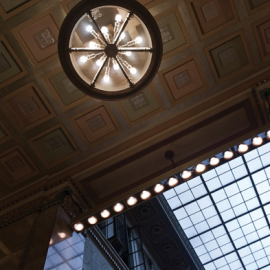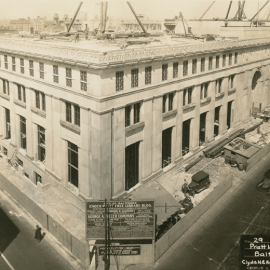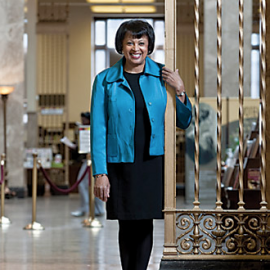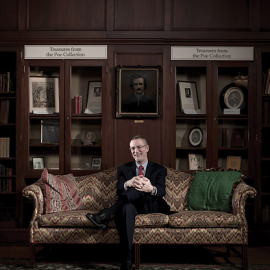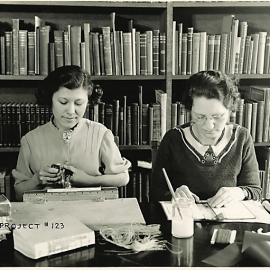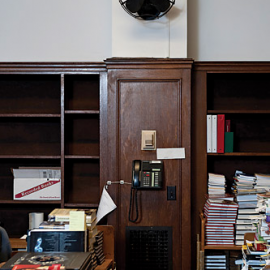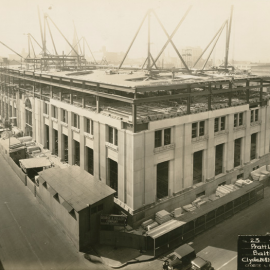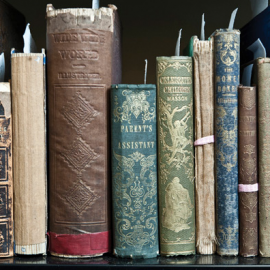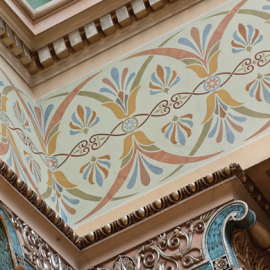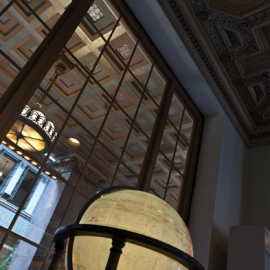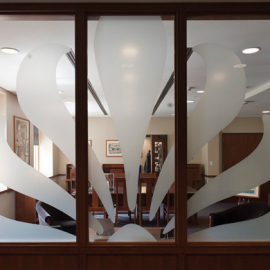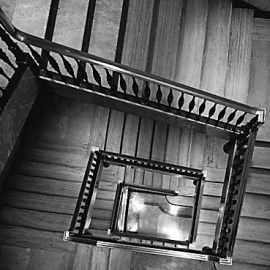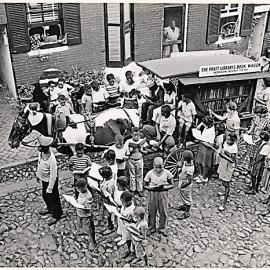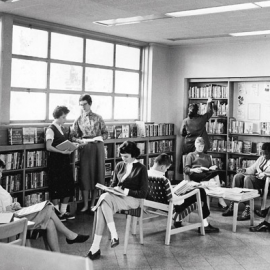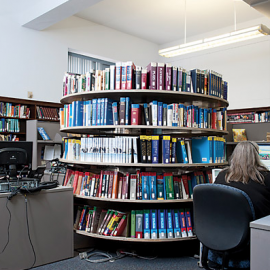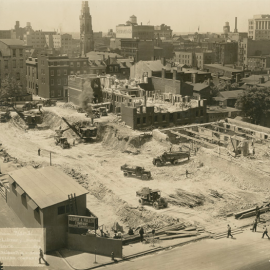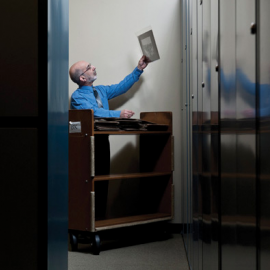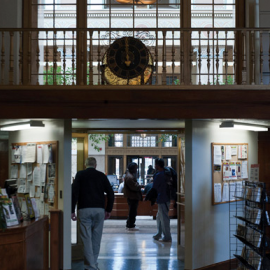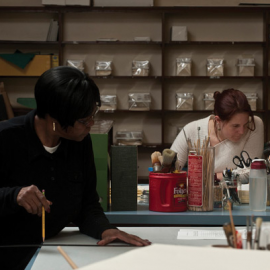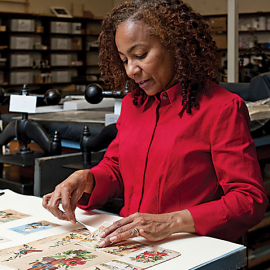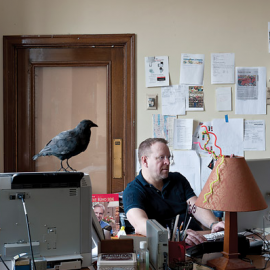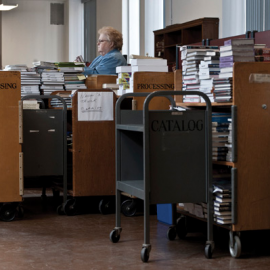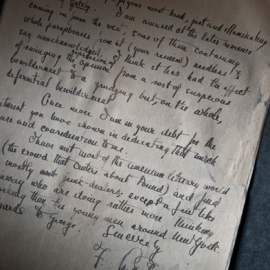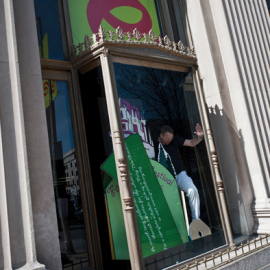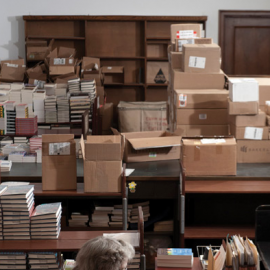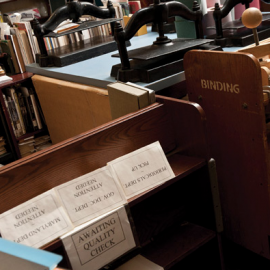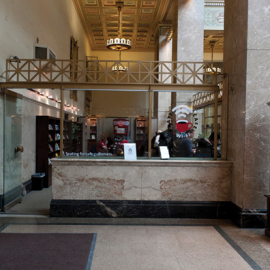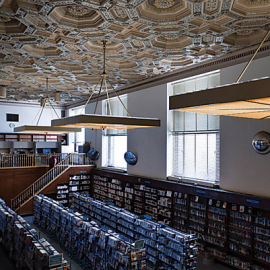Arts & Culture
Book/Smart
125 years after the Enoch Pratt Free Library opened, the egalitarian mission of its founder remains.
In 1831, 22-year-old Enoch Pratt, a former Boston hardware store clerk, moved to Baltimore, launching a wholesale hardware business at 29 S. Charles Street. Proving a successful merchant, he expanded his business interests to iron and coal, as well as horseshoe and nail manufacturing. A decade and a half later, Pratt built a family home at Monument Street and Park Avenue, walking to work and to Sunday services at the First Unitarian Church, past the location where the 125-year-old Central Library that bears his name stands today.
“Mr. Pratt was a frugal man,” says Wesley Wilson, chief of the Central Library/State Library Resource Center. “He was known to pick up nails from the street as he walked, knowing well the effort that went into making them.”
Frugal, perhaps, but generous and progressive-minded, as well.
In 1882, Pratt presented an endowment of $1,058,333 to the mayor of Baltimore and the City Council for the purpose of building the city’s first—and one of the nation’s first—public libraries.
“My library,” said Pratt, “shall be for all, rich and poor, without distinction of race or color, who, when properly accredited, can take out books if they will handle them carefully and return them.”
The Central Library, then on Mulberry Street, opened January 5, 1886, and the first four branches—including the Canton branch, still in operation—followed within the next three months.
In 1927, by a 3 to 1 margin, Baltimore voters approved a loan for a larger Central Library at its current Cathedral Street location across from the Baltimore Basilica. Building began four years later, and was completed despite the Great Depression.
Overseen by director Joseph Wheeler, the new library’s construction incorporated Pratt’s egalitarian mission, creating a street-level, department store model ahead of its time. In 1943, the library’s outreach effort expanded with the introduction of a horse-drawn book-wagon service. In 1953, children’s films were added.
Today, the Central Library’s reach has expanded exponentially, serving as both Maryland’s state library and a major urban lending institution. It’s a research home for Baltimore writers and filmmakers, from Barry Levinson to David Simon, as well as a center for job seekers. There’s a WiFi cafe, chess tables, and a wealth of material for amateur genealogists. Programming includes everything from GED classes to discussions with best-selling authors.
Of course, nothing is changing faster than the delivery system—or “container,” as Pratt CEO Carla Hayden puts it—of the library’s core product: books. At the forefront of library and information services, the Pratt has long offered e-book downloads, and this fall, will become one of a handful of libraries lending e-book readers.
With all this in mind on the Pratt’s 125th anniversary, Baltimore magazine spent a week behind the scenes at one of the city’s most cherished institutions—visited by 1.7 million people annually—to find out just what it takes to keep such a sprawling and efficient system in place. Short answer? A lot.
The Vault
March 16, 11 a.m.
Hidden Treasures
Behind the locked glass doors where the staff works on the second floor of the Central Library, chief Wesley Wilson turns an enormous combination lock on a bank-style vault—like something from an 1870s-era Western. Pulling the door open, he reveals a trove of literary treasures, many from Baltimore’s famous writers.
There’s a Paris letter from F. Scott Fitzgerald to H. L. Mencken, thanking the “Sage of Baltimore,” for reading the The Great Gatsby. Mencken’s diaries are here, as are several first-edition classics from his personal collection, including James Joyce’s Ulysses. There’s also the original copy of a library-contest-winning rap by Tupac Shakur, plus a CD of Shakur’s “The Eastside Crew,” performed while the aspiring rapper was studying at the nearby Baltimore School for the Arts.
A first edition copy of Virginia’s Woolf’s Monday or Tuesday, sits next to John Updike-signed novels. From the master of the macabre, Edgar Allan Poe, there’s a lock each of his and his wife’s hair, as well as a piece of his coffin.
One of the library’s more unique possessions stems from a discovery several years ago in the library itself. It’s a Megillah scroll, telling the story of Esther, completed in 1429 by a Persian scribe.
“It was located in our special collection’s uncatalogued stack, in a false book,” Wilson explains, pulling apart a small square that appears at first to be an actual book binding, but is actually the opening to a space where the scroll was stored. “It was left to us as part of a personal collection from a Baltimore Jewish family.”
The Wheel
March 18, 12:30 p.m.
An Answer to Every Question
Surrounded by floor-to-ceiling bookshelves and scattered six-inch thick tomes, four reference librarians sit at desks organized in a square configuration, facing each other. Plugged into computers and phones, the librarians answer questions from Baltimore, the state of Maryland, and, literally, the world—as they come in via telephone, e-mail, chat, and text message.
In the center of the desks, within arm’s reach of each librarian, spins what’s affectionately referred to as “The Wheel.” Completed in 1969, The Wheel, is a welded, seven-foot-tall, circular bookshelf, stacked with 800 reference titles, including The Dictionary of Classical Mythology, Facts About the States, The Baseball Timeline, and Larousse Gastronomique, a leading culinary resource first published in 1938.
Queries come from students and academics, and most are part of rigorous research, but people also regularly call for crossword puzzle help, last night’s winning lottery numbers, or an Orioles score.
Other queries are even stranger.
“Someone once asked, ‘Where do people go when they’re dead?’ Another asked, ‘Am I my cat’s mother?'” recalls library professional assistant Maggie Murphy, explaining all questions are taken seriously and provided the most credible answer found. “With the person who asked if they were their cat’s mother, we quoted a biology textbook that stated a cat is the product of two cats, and therefore she couldn’t possibly be the cat’s mother.” Psychologically or socially, Murphy noted, there may be a different answer.
A fresh query arrives asking if Gustav Holst’s orchestral suite, The Planets, included a movement for Pluto—de-planeted several years ago by the International Astronomical Union. Murphy shared with her client that Holst penned the suite between 1914 and 1916, before Pluto received planetary status.
Medical and legal queries are common: But Sonia Alcántara-Antoine, information services manager, cautions that those queries also point to the limited nature of the reference librarian’s role.
“As librarians we can’t give medical or legal advice,” she says. “We can cite medical or legal text, but we can’t interpret. We can’t go there.”
Graphic Jack’s Studio
March 18, 1:30 p.m.
A Window into the Art
“Everybody calls me ‘Graphic Jack,'” says Jack Young, extending a hand to a studio visitor. Behind him in his third-floor domain are life-size cutouts from Boris Karloff’s The Bride of Frankenstein. There’s also a Styrofoam black raven posing on a table, a nearly life-size installation of Rosa Park’s iconic Montgomery bus—complete with functioning headlights—plus mannequins, a gumball machine, an inflatable penguin (a gift from Fight Club author Chuck Palahniuk), frames, easels, scissors, and pencils.
Among other things, Young designs and installs the eight-foot-tall mini-billboards that fill the Pratt’s giant windows on Cathedral Street, which preview upcoming events. For example, when Obama campaign manager David Plouffe came in September to discuss his book, The Audacity to Win, Young gave him Shepard Fairey’s iconic two-color Obama poster treatment.
To promote the library’s annual Black & White Party this year, Young combined Cary Grant’s stark image from Hitchcock’s North by Northwest with a James Bond motif—in glamorous black, white, and red.
Whether it’s former Speaker of the House Nancy Pelosi, professional wrestler Chris Jericho, or an author presenting a book about the Haitian crisis, Young starts with research, seeking to develop a compelling image linked to the subject. He sketches concepts, typically on the first random piece of paper he gets his hands on, before moving to the computer.
“The first thing to consider is that people may not know the author, so the question is, visually, how do I let a lot of people know instantly who this person is that’s coming to Baltimore?” Young says. “In terms of text, 14 words is generally the limit. Cathedral Street gets a lot of traffic and it’s got to be read by someone driving by.”
Young also works on graphics for Pratt brochures, in-house exhibits, and library partners, such as the CityLit Project. One memorable work included a super-enlarged—20-foot by 13-foot—bird’s eye view of Baltimore City from a 1869 map. The map was placed on the floor of the library’s main hall and visitors walked and knelt on it, exploring where their home, church, or office stands today.
But it’s the windows the MICA graduate views as his calling.
“We redid the front and side windows about a year ago, and modified the lighting system,” Young says. “I consider the Basilica across the street our competition for people’s attention. These windows really need to pop.”
Plouffe asked for four copies of his oversize poster. Pelosi requested that hers be sent to her after her appearance. Practically everyone does the same.
“I’ve got a lot of work, I’m always running behind, very behind—and I’ve almost fallen off the ladder [installing posters],” Graphic Jack says, “but I love my job.”
Wheeler Auditorium
March 20, 2 p.m.
Highlandtown Girl Returns
“Hi everybody! Hello! Hi! How are you?” Sen. Barbara Mikulski says, bounding into the Central Library’s Wheeler Auditorium. “Hi Charlie! Hi kids!” And, then to a woman, “Are you the lady who e-mailed me?”
Mikulski’s appearance coincides with Women’s History Month. The previous day, the Pratt hosted an International Women’s History Month Literary Festival, with female writers from Trinidad, Iran, India, and the U.S. The Senator is here to give a talk called, “Women of the Senate: Making History, Changing History.”
Mikulski recalls a phone call from a Library of Congress staffer who informed her last summer that, if she won reelection, she’d be the longest serving woman in the history of the Senate. The Library of Congress needed “artifacts” from Mikulski’s career, and naturally, she put them in touch with the Pratt.
“In 1886, Enoch Pratt established the branch at O’Donnell Street and Elwood Avenue—that was my branch as a little girl going to the Sacred Heart of Jesus School,” Mikulski says. “That library card was my ticket, my window to the world.”
“To me, walking down to the Enoch Pratt was a big deal,” the 74-year-old continues, recalling how books transported her to different worlds. “I went to Switzerland and had a girlfriend named Heidi. I had a horse named Black Beauty.
“And Nancy Drew mystery novels,” she adds with a laugh, “helped prepare me for my Homeland Security and FBI oversight committee assignments.”
Landing a U.S. Senator for Women’s History Month is no small feat, but for coordinator of public programs Judy Cooper, it’s par for the course. Since being recruited from the Prince George’s library system 13 years ago, she’s transformed the library into a must-stop venue for writers. The fun ones, too.
Fight Club author Chuck Palahniuk made a memorable visit—tossing inflatable autographed penguins to a standing-room crowd. Ben Mezrich, The Social Network author, has been here, too.
On the heels of Barack Obama’s election, Bill Ayers’s visit created a barrage of nasty phone calls and e-mails, as well as a small protest at the library when he and his wife, Bernadine Dohrn, came to discuss their book, Race Course: Against White Supremacy.
“We’ve invited Bill O’Reilly in the past, and we’re trying to get [Republican Senator] Scott Brown,” says Cooper, highlighting the library’s nonpartisan efforts.
Scheduled for April 26, the rapper Prodigy, who recently published a memoir, was expected to pack the place.
“The events are free and we don’t pay most of these authors,” Cooper says. “They want to come here.”
Bindery Department
March 18, 12:30 p.m.
The Secret of Wheat Flour Paste
Upstairs in a quiet room filled with medieval-looking devices, book conservator Martha Edgerton readies a memorabilia scrapbook kept by H. L. Mencken for repair. The spine is torn at the edge and the text block broken, requiring sewing.
Nearby, Baltimore’s 200th Anniversary, 1729-1929, a print and photo collection, rests loose from its broken binder. “It needs a new cover,” Edgerton says. “It’s beyond repair.”
The older books hold up better than newer books, she says. The natural-fiber paper used before the early and mid-1800s, she explains, is almost fabric-like and lasts longer than wood-pulp paper.
“It’s an inferior product that’s used today,” Edgerton says, lifting a compilation of newspapers from the 1830s still close to their original color. “The acid content breaks everything down quicker. These newspapers look better than a Baltimore Sun that’s several days old.”
Book and letterpresses, decades old—and a guillotine-esque machine for slicing boards into book covers—sit on benches as volunteers tend to the careful work of preserving the library’s assets.
There’s newer technology, too: an ultrasonic welder for polyester encapsulation, which protects paper between pieces of chemically inert, clear plastic sheathing—safer than lamination. But the Old World techniques—the antique “Property of the Enoch Pratt Free Library” stamping machine and the homemade wheat-flour recipe for paste—serve as reminders of a timeless art.
“We wouldn’t want to use synthetic glue—it’s permanent,” Edgerton says. “It can’t be undone if the book is damaged in the future. The wheat-flour recipe can be reversed with water if necessary.”
Shipping and Receiving
March 16, 9:30 a.m.
Moving Pages
Loaded by 8 a.m., Enoch Pratt vans are making their way across the state, toting book bins that will eventually arrive in Bethesda, Cumberland, the Eastern Shore, and even the city’s jail. Now, Wendy Allen, the Pratt’s resource delivery manager, and her team begin filling new computerized orders, placing materials in 80 separate bins marked CECL, CARO, AACO, and HARF, among others, for tomorrow’s deliveries.
In Frederick, someone’s requested The Three Little Witches Storybook, which was located in a Harford County branch and sent here to be forwarded to the Frederick branch. A Montgomery County request for mystery/cookbook Parsley, Sage, Rosemary and Crime was located in Howard County and also will leave tomorrow. Roughly 66,000 items are shipped monthly through the Pratt—the hub of the state library system.
The logistics seem daunting—the shipping office is broken down into requests from the two-dozen Baltimore City branches, the bookmobile, and the statewide county runs—but there’s a system.
A Pratt truck loaded with books for the Queen Anne’s branch, for example, meets one from the Eastern Shore just over the Bay Bridge each morning, and they exchange payloads. Likewise, a Pratt truck covering Frederick County meets and swaps orders with one from Western Maryland, which then heads to Allegheny, Washington, and Garrett Counties.
On one shelf sits a volume of Michie’s Annotated Code of Maryland, headed to the Baltimore City Detention Center library on East Eager Street.
“It’s not true that [prisoners] only ask for legal books,” says Barbara Collins, a supervisor in the shipping office, on the job for 33 years. “They ask for everything, the same books as everybody else.”
Material Selections
March 18, 9 a.m.
Creating a Virtual Library
In an office down a long, narrow hallway on the second floor, Sarah Kuperman, who works in the collections management department, flips through an industry catalogue of book reviews. She’s looking for potential nonfiction additions for the Pratt system.
Kuperman chooses which, and how many, new $24.95 titles the library needs—and can afford—to stay current. For the past decade, she’s overseen the selection of business, science, and technology books, as well as tomes on philosophy and most of the world’s religions.
The two-inch-thick industry guides help. Kuperman also relies on The New York Times bestseller lists, among other sources. Like everyone, she wishes she had more time to read all the books she selects.
“I try to stay within the amount of money given by my boss,” says Kuperman, who is working with a budget of about $15,000 a year for a specific project. “It’s a whopping sum for a public library. The entire system has a budget of about $2 million a year for new materials.”
At her computer, Kuperman begins sifting through data from Overdrive, the library’s vendor for e-books and downloadable audios. This is where everything is changing, and the rules still evolving.
Audio downloads, available through the Pratt since 2006, have increased 12-fold. And now e-books are transforming publishing—and libraries. On her screen, Kuperman can see which e-books are being downloaded at each branch, and where e-books are on hold.
Technically, publishers could easily offer unlimited downloads of their titles. However, they limit the number of times each purchase of an e-book by the library can be downloaded by borrowers—simulating the number of times each hardcover can be borrowed, for example, in a given year.
At the moment, Kuperman needs to order more downloads of The Weird Sisters, by Eleanor Brown. Currently, the Pratt consortium owns 18 downloadable copies, 14 of which are out, with 36 holds at various institutions.
Contrary to stereotype, older readers have been among the early adopters of this new technology—because of the adjustable font. The most popular e-books from the Pratt reflect an older clientele’s interests: a historical novel by Ken Follett, Flannery O’Connor’s A Good Man is Hard to Find, and The Accidental Tourist by Anne Tyler.
Kuperman wishes more people knew about the library’s e-books. She also says “digital” seems like a quaint word today.
“I want to use ‘virtual library,'” she says.
Main Hall
March 17 (St. Patrick’s Day), 10 a.m. to noon
The Footnotes
In a city known for early morning lines outside its methadone clinics, there’s another line that forms every morning—on the sidewalk in front of the Pratt. Close to 50 people gather, waiting to get into the stacks, begin research, borrow a DVD, and use the public computers, including four terminals dedicated to job hunting.
There’s also coffee and free Wi-Fi in the cafe.
Some come early for chess matches with two-foot-tall knights and bishops on the library’s black-and-white-checked floorboard.
It’s St. Patrick’s Day, and Enoch Pratt CEO Carla Hayden takes in the scene in the main hall from upstairs. Three of her staff members, a guitarist, a violinist, and a mandolin player, occasionally known as the Footnotes, are performing Irish music for library visitors. Hayden descends the stairs to pass out cookies.
Hayden, who missed Barack and Michelle Obama’s wedding (they were her neighbors in Chicago’s Hyde Park) to accept the Pratt position in July of 1993, has kept the institution at the forefront of library science for nearly two decades. She won the National Librarian of the Year award in 1995, vocally opposed the Patriot Act’s intrusion into public libraries, and earlier this year, was named a member of both the National Museum and Library Services Board and the National Foundation on the Arts and the Humanities.
St. Patrick’s Day was as good a day as she can recall at the library.
“We’re sitting in the Edgar Allan Poe Room and I hear music coming from the Central Hall, and its three staff members playing Irish music,” Hayden says. “There’s 30 to 40 chairs down there filled with senior citizens, younger adults, and some African-American kids listening to somebody on our staff playing guitar. There’s a mother with three little girls down in front, and a Hispanic women, who has a child with her—and books.”
“The diversity of the people was amazing,” Hayden continues. “And I thought, ‘That’s what this is about. That’s what this library’s mission has always been about.'”
